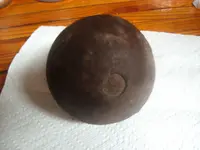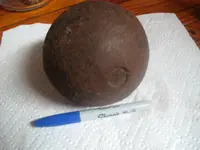In actual well-documented fact, you CAN hit a cannonball all day long with a hammer, and nothing will happen except your arm gets tired. I do exactly that, often, in cleaning the rust-crust off of them. Been doing it to hundreds of cannonballs, for nearly 40 years, and I can still count to ten on my fingers. (Check the info in my Profile under "About me.") The un-deniable proof: we relic-hunters have dug up more than 100,000 civil war shells, nearly every one of which got struck with the shovel (several times) during the digging... without causing a single one of them to explode. The very-very-few
civil war era ones which have exploded did so because somebody was using a power-tool (such as a drill) on it, or put it into a bonfire, for thrills. It's the 20th-Century projectiles you need to worry about. The problem is, most people cannot tell the difference between a civil war artillery shell and a 20th-Century shell... so, it's best to be properly cautious (but not Paranoid) about bullet-shaped ones. Anybody who owns one and is uncertain about its time-period can post photos of it here in the What-Is-It forum for identification and time-period dating.
Svterry/Vicki, welcome to TreasureNet and the What-Is-It forum.
Your final photo seems to show a number on your iron/steel ball. If that
is a number on it, it is not an artillery ball. If the number is a 12, as it seems to be, it is a Sports Shot Put ball. Absolutely no actual cannonballs were marked with their weight, in any era of artillery history.
The simplest way to tell if an iron ball is a cannonball or not is to weight it on a
precision weighing-scale, such as a Postal Shipping scale, which measures weight in not just pounds but in ounces too. (Typical household bathroom scales are horribly inaccurate -- so forget that kind.) If the ball's weight doesn't match up
precisely with one of the weights given in the Ordnance Manual data at the following website, it is not an artillery ball.
Cannon bore, shot, and shell diameters for smoothbore guns
The Ordnance Manual's historical data-charts tell the exact diameter and super-precise weight of every kind of artillery ball (cannnon-ball, grapeshot-ball, and canister-ball) used in America from the American Revolution through the end of the Civil War. If you can't find a matchup in the Historical data for your iron ball's exact diameter (not counting any rust/dirt-encrustation, which must be removed) and precisely-measured weight, it is absolutely not an artillery ball. (or at least, not one used in America.)








